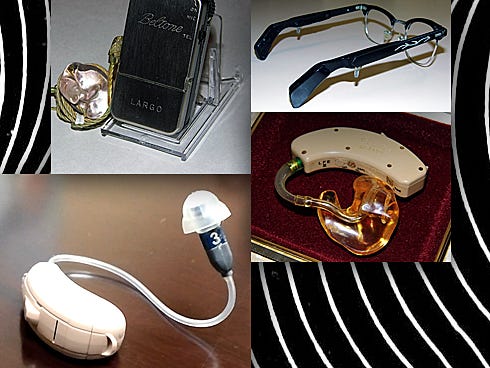
CRESTVIEW — Aging, genes, medications and loud, noisy work environments can contribute to hearing loss, according to the Mayo Clinic.
Many people rely on hearing aids to effectively communicate. And over the years, this basic necessity has become more user-friendly.
"In the past, hearing aids were more of a nuisance," said Cameron Yordon, a licensed hearing aid specialist with Beltone in Crestview. "But nowadays, with this new technology, it's more become a lifestyle change. It's more of a luxury now."
Remote controls, iPhones and iPads can adjust a hearing aid's volume, and an app can even track lost hearing aids with GPS. Relatives can Skype or listen to music, with audio from a computer feeding directly into the hearing aids. And hearing aids can adapt to outdoors or restaurants settings with the touch of a button.
"It's become so much simpler now," Yordon said.
Here's a history of the device:
Body-style transistor hearing aid. "People had a box about the size of a beeper with a cord that went up to your ear with the ear mold in it," Greg Yordon, Beltone's Northwest Florida manager, said.
Though bulky compared to today's devices, the transistor hearing aid — manufactured throughout the late 1940s and 1960s — was still stylish.
For instance, Beltone's 2-ounce Largo model — 2 1/2 by 1 5/16 by 5/8 inches — featured a brushed stainless steel case over a black plastic chassis, according to HearingAidMuseum.com.
Eyeglass hearing aid. For more than 20 years, a device that improved not just audio but also vision was in demand.
Beltone's "Invisible" series — among a number of eyeglass products the company manufactured from 1955-1979 — hid the microphone and battery door inside the eyeglass frames' temple pieces, according to HearingAidMuseum.com.
At one point, in the late 1950s, these hearing aids made up 50 percent of the market, according to the Washington University School of Medicine.
Though available past its peak, the eyeglass hearing aid was a trend that Sharon Yordon, who also manages Beltone's Northwest Florida offices, was glad to see go away.
"Eyeglasses were very hard to adjust and we were always having to coordinate with the eye centers and so forth to do that … that was difficult," she said.
Behind-the-ear aids. This analog device — such as Beltone's "Minuet II," which became available in 1976 — trimmed some of the bulk and added convenience.
Users could control volume and replace batteries directly on the earpiece, the only piece.
BTEs gave way to later models and innovations, including in-the-ear models, those worn entirely in the canal, and programmable hearing aids that allow more fine tuning, Greg said.
"As hearing loss changed, we were able to keep up with it," providing smoother sounds with just the touch of a button, he said.
Customers notice the difference, Sharon said.
"When they walk in with a problem, you could just hook it up to the computer, make adjustments and they're like, 'Wow, what a difference! That's terrific!" she said. "And they're out the door."
LEARN MORE
Want to learn more about hearing aids? Beltone's new Crestview office is located at 2670 S. Ferdon Blvd., Unit 105. Call 683-8777 for free hearing screenings.
This article originally appeared on Crestview News Bulletin: 'MORE OF A LUXURY NOW': Hearing aids have changed over the years
